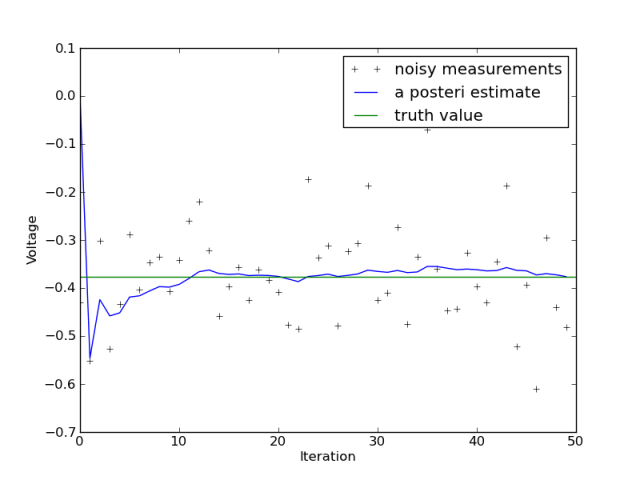# Kalman filter example demo in Python # A Python implementation of the example given in pages 11-15 of "An # Introduction to the Kalman Filter" by Greg Welch and Gary Bishop, # University of North Carolina at Chapel Hill, Department of Computer # Science, TR 95-041, # http://www.cs.unc.edu/~welch/kalman/kalmanIntro.html # by Andrew D. Straw import numpy import pylab # intial parameters n_iter = 50 sz = (n_iter,) # size of array x = -0.37727 # truth value (typo in example at top of p. 13 calls this z) z = numpy.random.normal(x,0.1,size=sz) # observations (normal about x, sigma=0.1) Q = 1e-5 # process variance # allocate space for arrays xhat=numpy.zeros(sz) # a posteri estimate of x P=numpy.zeros(sz) # a posteri error estimate xhatminus=numpy.zeros(sz) # a priori estimate of x Pminus=numpy.zeros(sz) # a priori error estimate K=numpy.zeros(sz) # gain or blending factor R = 0.1**2 # estimate of measurement variance, change to see effect # intial guesses xhat[0] = 0.0 P[0] = 1.0 for k in range(1,n_iter): # time update xhatminus[k] = xhat[k-1] Pminus[k] = P[k-1]+Q # measurement update K[k] = Pminus[k]/( Pminus[k]+R ) xhat[k] = xhatminus[k]+K[k]*(z[k]-xhatminus[k]) P[k] = (1-K[k])*Pminus[k] pylab.figure() pylab.plot(z,'k+',label='noisy measurements') pylab.plot(xhat,'b-',label='a posteri estimate') pylab.axhline(x,color='g',label='truth value') pylab.legend() pylab.xlabel('Iteration') pylab.ylabel('Voltage') pylab.figure() valid_iter = range(1,n_iter) # Pminus not valid at step 0 pylab.plot(valid_iter,Pminus[valid_iter],label='a priori error estimate') pylab.xlabel('Iteration') pylab.ylabel('$(Voltage)^2$') pylab.setp(pylab.gca(),'ylim',[0,.01]) pylab.show()
